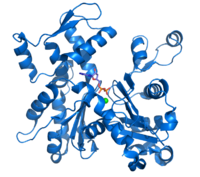
Photo from wikipedia
Type of funding sources: None. Cardiac amyloidosis (CA) causes a restrictive cardiomyopathy, generally associated with symptoms and poor prognosis. Echocardiography plays a fundamental role in its diagnosis, and can also… Click to show full abstract
Type of funding sources: None. Cardiac amyloidosis (CA) causes a restrictive cardiomyopathy, generally associated with symptoms and poor prognosis. Echocardiography plays a fundamental role in its diagnosis, and can also provide important prognostic information. Although left ventricular global longitudinal strain (GLS) has been studied using speckle-tracking echocardiography, and is known to be predictive of outcome, RV and LA involvement evaluated by deformation pattern is not yet well defined. The aim of this study is to characterize LV, RV and LA involvement in patients with CA, and to evaluate whether parameters of myocardial deformation of these cavities are correlated with functional class and/or number of hospitalizations in this group of patients. We included 19 patients diagnosed with CA between 2021 and 2022. Demographic, clinical data and echocardiographic parameters were collected, including diastolic function parameters and study of myocardial deformation, using the speckle tracking technique of left ventricle, right ventricle, and left atrium. Statistical analysis was performed to evaluate the association between symptoms and imaging parameters. The mean age was 66 y.o. 77% male. The percentage of Cardiovascular risk factors was HTN 77%, DM 23%, dyslipidemia 23%. CAD 15%. Hospital admission in last year 23%. NYHA functional class II 23%. All echocardiographyc parameters and and significant correlations are showed in table 1. Regarding basic echocardiographic parameters, mean LV and RV systolic function was in normal range: LVEF 64%; RV TAPSE 21mm; mean Tricuspid annular peak systolic velocity 11,6cm/seg; RV fractional area change 40%. Concerning deformation parameters RV and LA parameters were decreased, RV free wall longitudinal strain -26,8%; RV four-chamber longitudinal strain -21,7%; LA reservoir strain 26,6%; LA conduit strain -15,1%; LA contractile strain -11%, although not significantly associated with a worse NYHA functional class or a higher number of hospital admissions, possibly due to a low sample size. In addition, a larger LA area and volume, shorter deceleration time and worse GLS correlated statistically significantly with a worse NYHA functional class, while a larger LA diameter and mean E/e' correlated with a higher number of admissions. Echocardiography is a non-invasive, fast and simple diagnostic tool. Strain data from different cardiac chambers would allow early detection, or at least suspicion, of this entity. In addition, strain data of left atrium and right ventricle would allow to predict evolution and to be an important prognostic factor. Atrial and ventricular strain have promise for clinical utility.
Journal Title: European Heart Journal: Acute Cardiovascular Care
Year Published: 2023
Link to full text (if available)
Share on Social Media: Sign Up to like & get
recommendations!